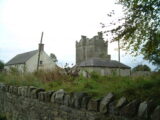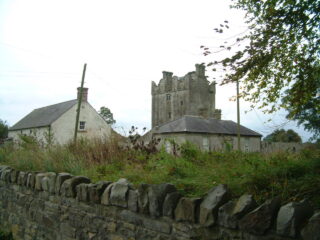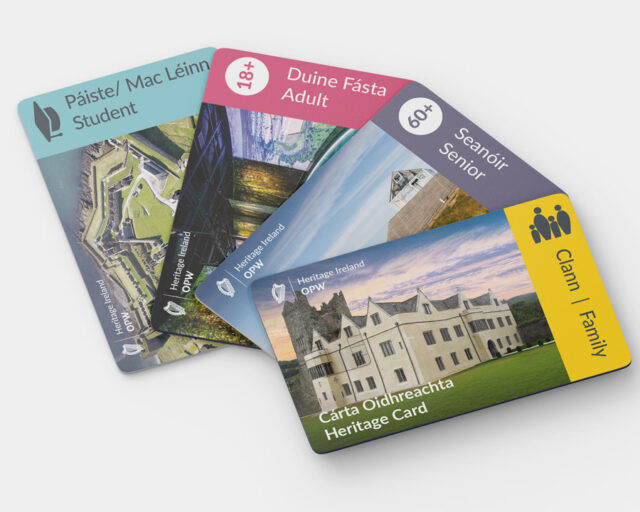Fógra
WARNING: It should be noted that these sites are unguided and a level of care and caution should be maintained during all stages of your visit. The Office Of Public Works (OPW) will not be held responsible for any damages, injuries, or losses that occur
Grange Castle
Historically associated with the two Anglo-Norman families of Birmingham and Tyrrell,Grange Castle is a modest but important and largely intact medieval tower house, attached to which is a later symmetrically-elegant single-storey Georgian-era residence, known as Fallon Hall. The property is located in the townland of Grange West, in Co. Kildare.
Grange Castle sits in a grouping of Birmingham family properties in the surrounding countryside, which include Carbury Castle and Carrick Castle in County Kildare, as well as Blundell Castle, Kinnefad Castle, and Monasterois Monastery in neighbouring Co. Offaly.
Almost perfectly square and sitting on a batter base, Grange Castle was constructed by the Birminghams around AD 1460 and was embellished with nine ornate Jacobean chimneys and semi-circular battlements in the early 17th century. Probably also dating to this period are the carved and mullioned punch-dressed window frames, some pointed and others flat-headed, with their inset lattices of leaded diamond-shaped glass.
Internally, a narrow spiral staircase connects all of the tower house’s four floors. Inset into the ground-floor base-batter is a handsome round-headed opening which has a punch-dressed and chamfered triangular limestone surround. It sits directly above what was discovered recently to be a 19th century millwheel of some design. How the two relate to each other is not yet known. A garderobe, or otherwise a machicolation, (which does not appear to be sited over any obvious ground-floor entrance) projects from the roof level.
Grange Castle is said to have survived Cromwell’s destructive mid-17th century campaign in Ireland, when aid was given by the Castle’s family members to one of the Parliamentarian soldiers.
In 1735, Walter Bermingham sold Grange Castle to Thomas Tyrrell, in whose family it remained until it was sold to Dúchas/The Heritage Service and subsequently transferred into the care of the Office of Public Works as a National Monument in 1988.
Of Norman origin, the Tyrrell family’s coat-of-arms, and their family motto of ‘Veritas Via Vitae’ (‘Truth the way of life’), are displayed in the pointed pediment over the west-facing front door of the Fallon Hall residence. This pediment sits on top of very finely-carved flat and fluted pilasters, crowned by a pair of fluted corbels, between which is a very delicately ribbed semi-circular limestone frieze.
The Tyrrell family trace their origins to Poix in Picardy and Guernanville in Normandy and a privately-printed genealogical history of the family can be read in the National Library of Ireland. Sir Hugh Tyrrell, Chevalier and Prince of Poix, joined the second Crusade of AD 1146. He was married to Ade, daughter of Etienne de Champagne, Count d’Aumale and, following the Norman conquest of England in 1066, held the Manors of Kingsworthy near Winchester, Avon Tyrrell, and lands at Ripley, Shirley and Sopley in the New Forest. Sir Hugh died in 1159, being succeeded in Poix by his eldest son Walter, who died without issue in 1171, and subsequently by his second surviving son, also Sir Hugh, known as ‘The Grecian Knight’.
In the spring of 1169, Strongbow, Earl of Pembroke, sent Raymond Fitz William Fitz Gerald, otherwise known as Raymond le Gros, into Ireland with the younger Sir Hugh Tyrrell and nine other Knights and seventy archers. They landed at a rocky headland of Dundunnolf, four miles east of Waterford. This location is better known today as Baginbun, near Bannow in Co. Wexford.
On the 23rd August 1170, Strongbow and twelve hundred men arrived at Waterford, and on the 17th October 1171 Henry II, King of England, landed at Crook near Waterford. Here he appointed Sir Hugh de Lacy as Lord Palatine of Meath, in consideration of the services of fifty Knights, including Sir Hugh Tyrrell, who from thence on known as “De Lacy’s Barons”.
In 1173, the Kingdom of Meath was divided by De Lacy between these Barons, making Sir Hugh Tyrrell Baron of Castleknock. The 12,000 Irish acres of land that he was granted included the parishes of Killsallaghan, Ward, Cloghran, Chapelizod and Castleknock.
Fallon Hall remained in the ownership of the Tyrrell Trust Ltd, which was set up in 1995 with a view to restoring the property to something of its former glory. This effort came to nothing and the Trust was disbanded in 2003. Although Grange Castle's tower house appears to be weathering the worst of its destructive effects, nature now seems set on inexorably reclaiming the house, the cottage and outbuildings, and the abandoned walled gardens. Consequently, care is advised if a visit to the Castle is being planned and respect is required to the fact that the Georgian-era house still remains in private ownership.
Visit Historic Environment Viewer for more information on Grange Castle
Protect our Past - Click here to read about the importance of protecting our country’s unique heritage sites
This national monument is protected in accordance with the National Monuments Acts 1930 to 2014


